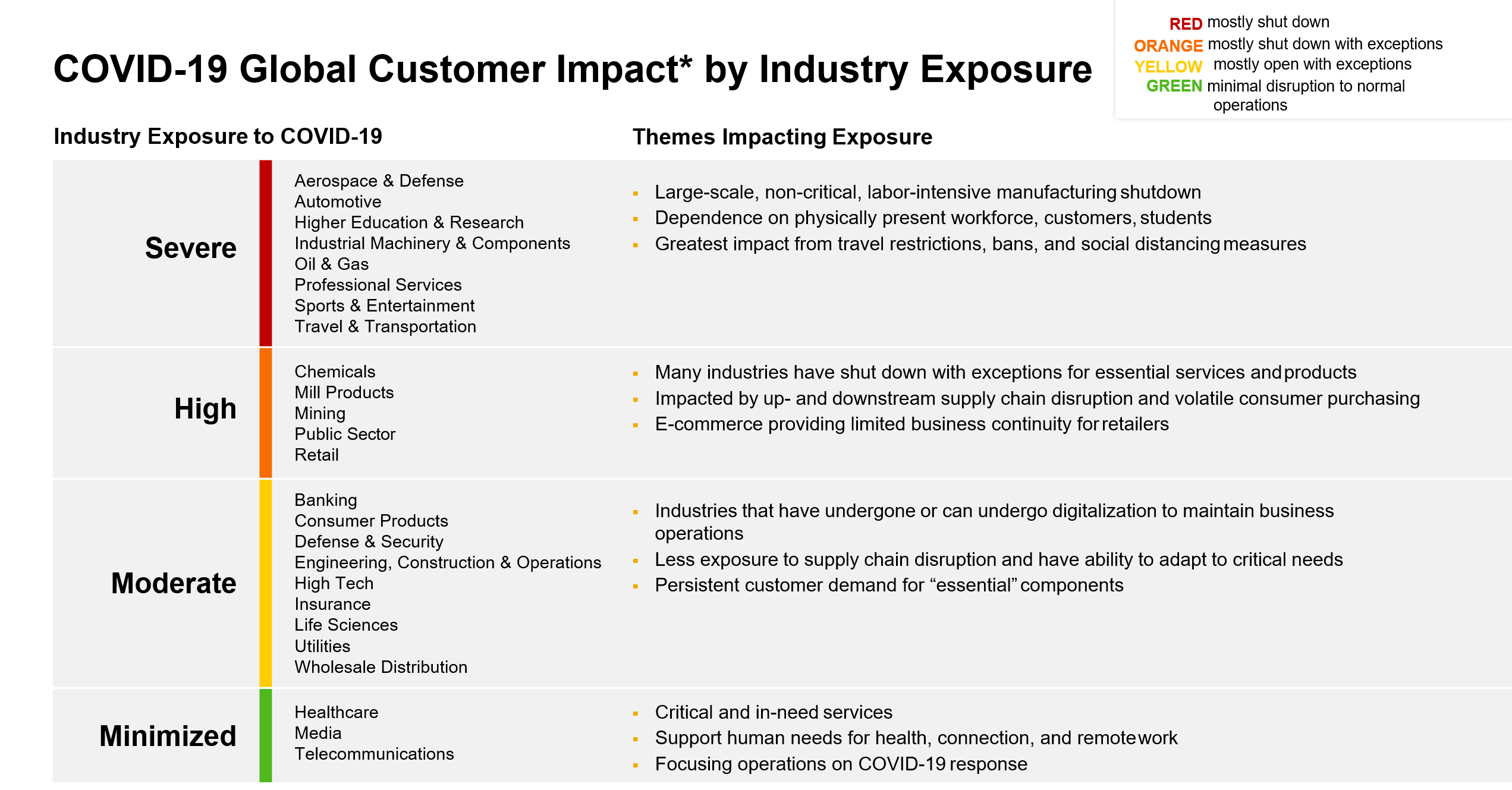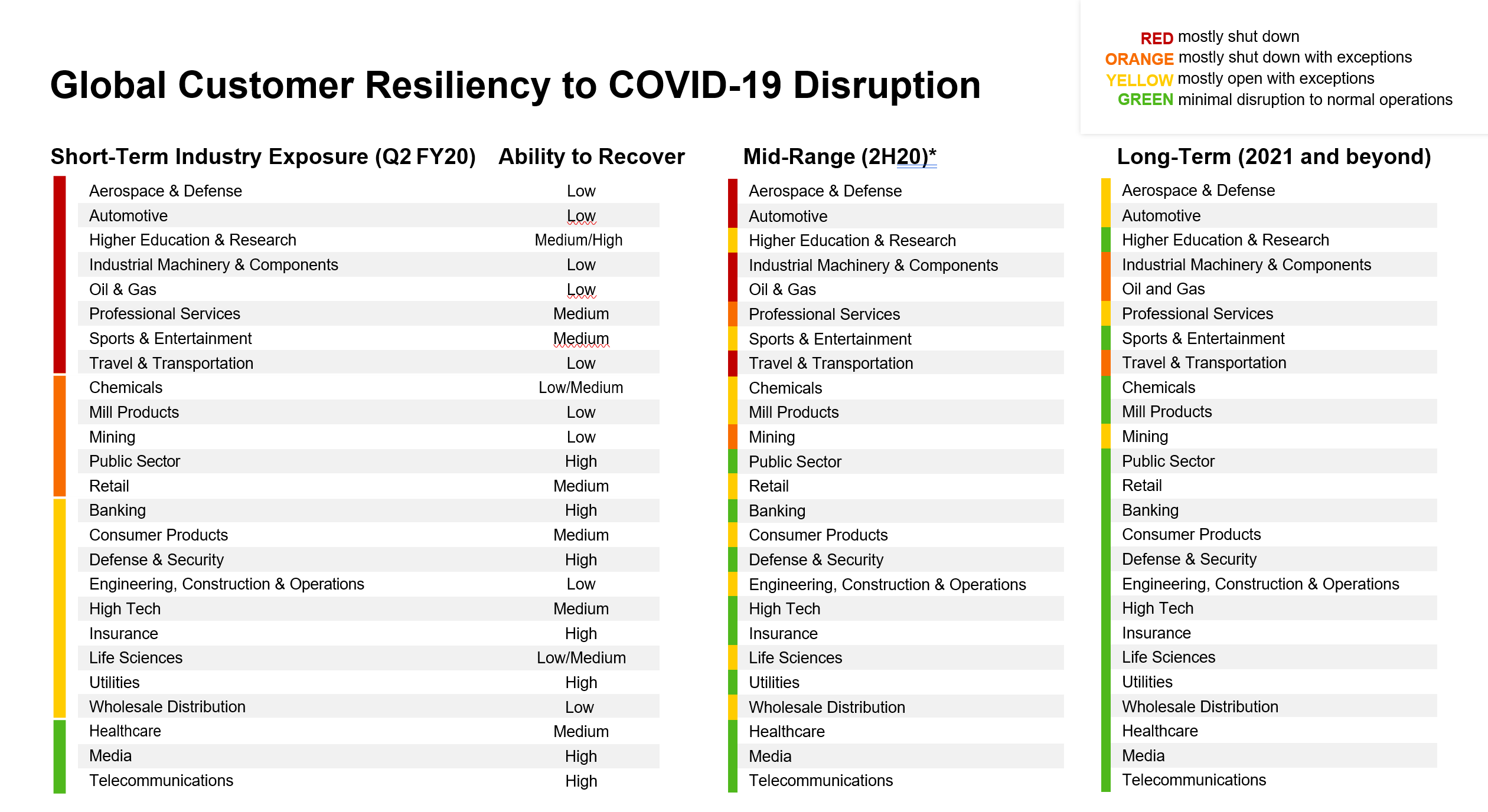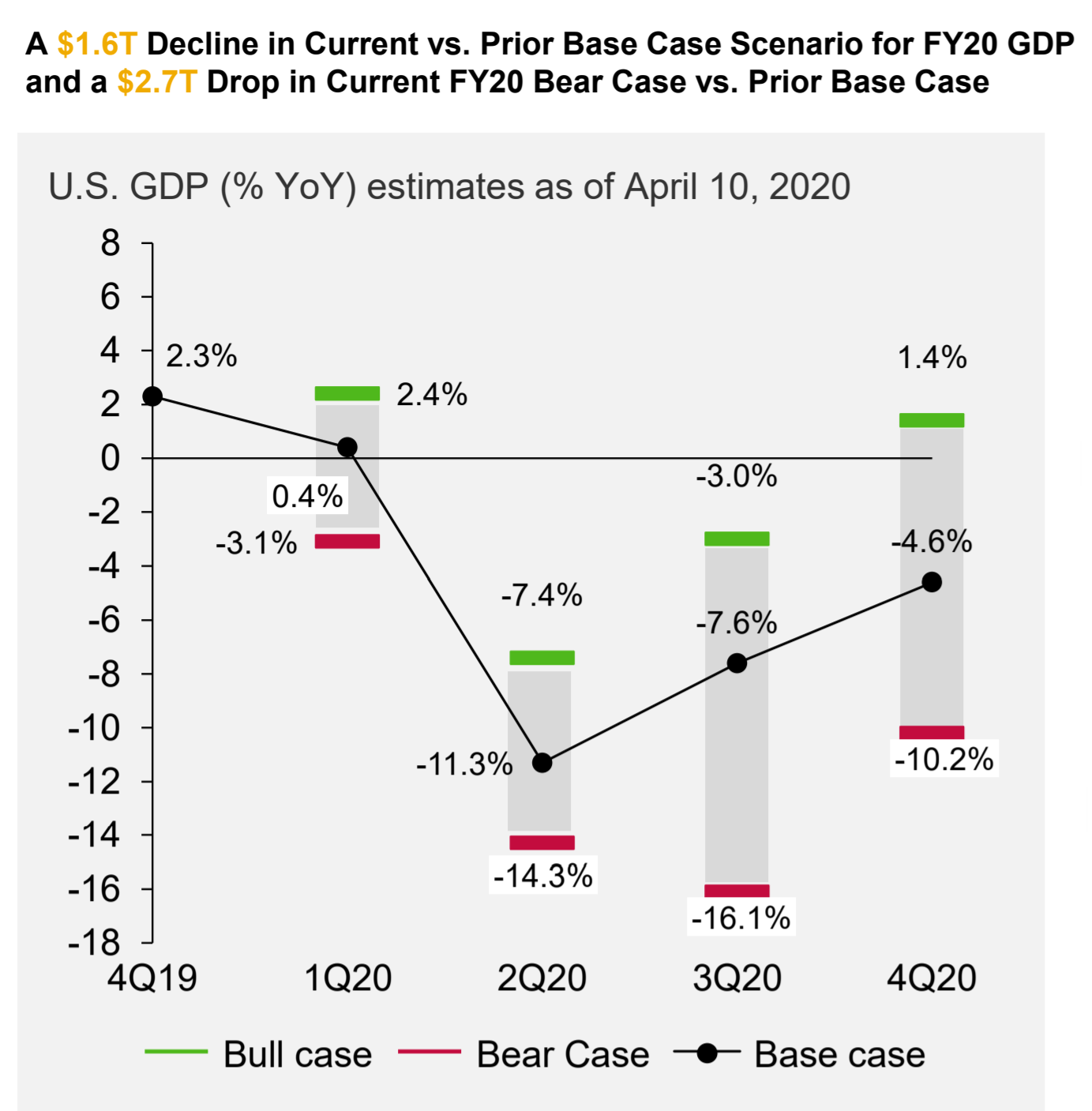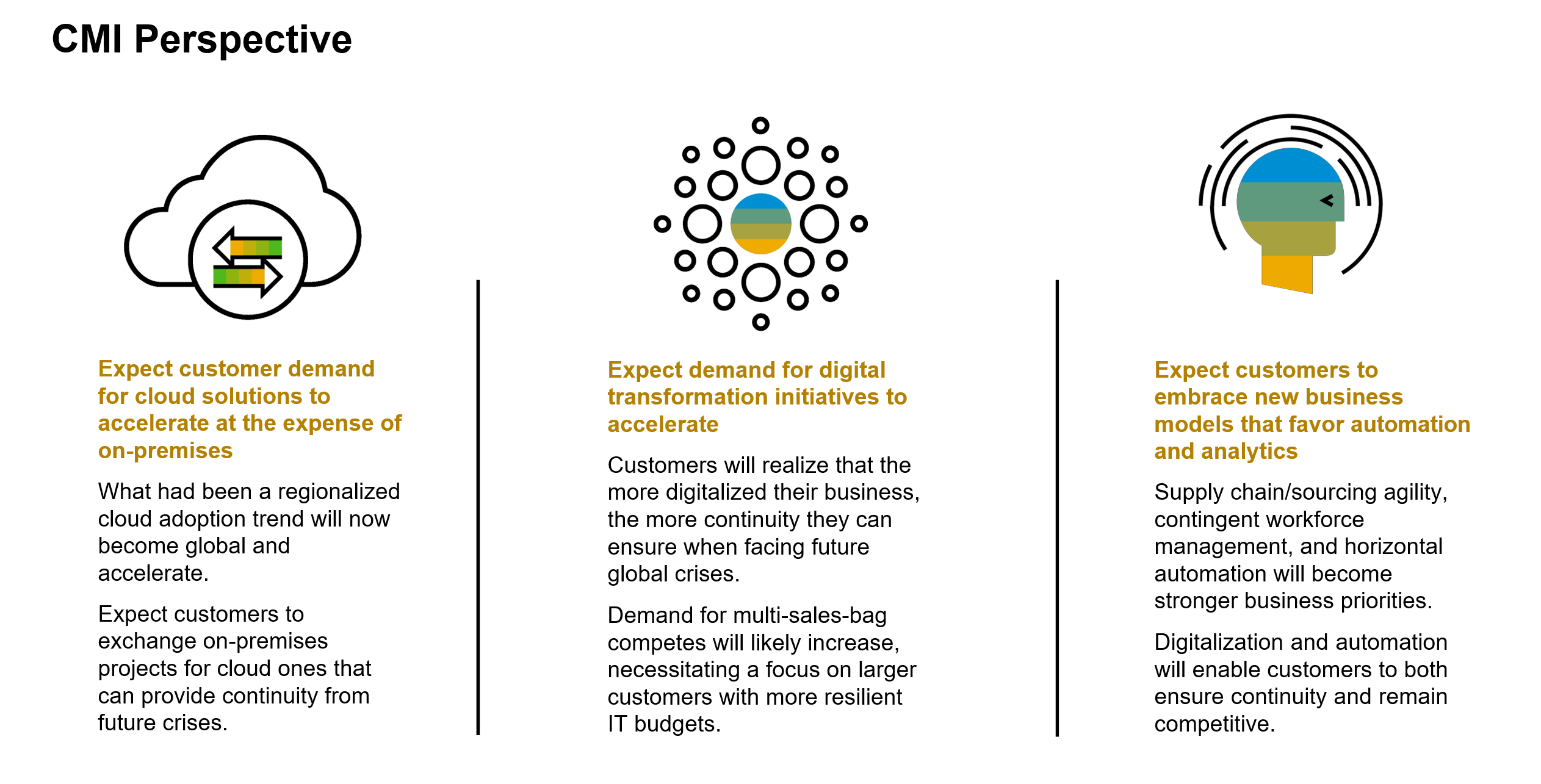COVID-19 is a humanitarian crisis that is also creating an unprecedented business disruption.
All businesses are facing exceptional challenges right now as the impact on the global economy continues. Business travel is restricted, events are cancelled, and supply chains have been weakened — it is not “business as usual” in any sense of the phrase.
The current impact so far:
- Over 100 countries representing well over 2 billion people are currently in lockdown, with India most recently adding 3 billion to that total. China had earlier locked down 500 million across 48 cities,
- Service- and manufacturing-intensive industries across sectors are experiencing drastic slowdowns. Many airlines, hotels, and restaurants are operating at less than 10% capacity, and factories are suspending production,
- Crude oil prices have dropped ~60% from December highs as a price war and suppressed demand hit,
- Simultaneously, the oil & Gas industry is at risk of deferring billions of capital projects as a result.
- New unemployment filings in the U.S. are expected to spike to well over 6 million workers, a trend now playing out globally as service, factory, and ‘gig’ workers are impacted first
- Global stock markets have retreated >30% on average, representing the fastest decline in securities of any prior stock decline (’87, ’01, ’08, etc.)
- S.: 1- and 3-month Treasury bill yields fall below zero (negative rates). Spot gold rose to over $1,600/oz on a flight to safety move (in addition to other precious metals)
- S. Gov reaches historic $2T deal on a stimulus bill. Chinese Gov waived employer social contributions of RMB 124B in February and encouraged banks to lend to businesses (the PBoC set aside RMB 800B of re-lending).
- Roughly $1.2T in untapped revolving credit lines for issuers. As corporations increase draw down on revolving credit lines, the ability of U.S. and global banks to provide liquidity has come into question
So how do we look to the future and anticipate our investments in time and money. A recent study compiled by SAP gives us some guidance:
Assumptions:
Timing: Assumes an optimistic scenario where quarantines and government lockdowns are successful in mitigating the spread of the virus and “flattening” the curve by the end of Q2 FY20, resulting in a staged re-opening of communities by the end of Q3 FY20, and a beginning to business recovery in Q4 FY20.
Global: Reflects an aggregate (or averaged) global view, recognizing that each country is potentially on its own “curve” and some will rebound earlier than others.
Macro Industry: Reflects macro -industry categorization (macro SIC code), recognizing that within a macro industry there will be sub-industries that are impacted much differently than others, and there may be counter-growth trends at the sub-category level.
GDP vs. IT: Reflects the general impact to an industry’s total global economic output for the year (GDP), which may or may not trend similar to IT spend in that industry due to specific characteristics that either reduce or increase spending on specific IT-related capabilities during the rebound.
Macroeconomic: Assumes a mild economic recession, including massive short-term disruption to employment, but mitigation by government stimulus
This research analyzed 25 industries from a global perspective, assessing each industry’s resiliency to COVID-19
COVID-19 Global Customer Impact by Industry:

The Global Customer Resiliency to COVID-19 Disruption
“This will be a deep but shorter recession. This public health crisis is more akin to a natural disaster and we are getting a more aggressive policy response, the market will recover to pre-Covid-19 levels by 3Q21 (i.e., 7 quarters) compared with 14 quarters during 2009 Global Financial Crisis.” Deutsche Bank
“We expect a rebound in global growth starting in Q3. Policy measures to help firms and households make necessary payments are very helpful. But recovery expectations might be “the best of possible worlds.” We are on the lookout for downside risks.” Goldman Sachs
The market trend below depicts the resiliency to COVID-19 and the ability to recover from COVID-19

How Long Will It Last?
- “A sharp increase in unemployment is inevitable, but appropriate stimulus can set the stage for a v-shaped recovery once contagion risk eases. In our base case, growth begins to pick up going into the summer, with H2 growth averaging 9.7%” Morgan Stanley
- “We expect economic activity to recover at a weaker pace in the US in 3Q20. The deep shock and the gradual return of economic activity will mean that output levels reach pre Covid-19 levels by 4Q21 in the US and 3Q21 in EA. Morgan Stanley

What to Expect in the upcoming months in information technology?
- Expect companies will accelerate cloud solutions to at the expense of on-premise solutions
- Companies that have not hitherto invested in cloud technologies are finding themselves at a disadvantage to those that have. The ability to scale down (and in some cases scale up) is compromised without a cloud option.
- Expect demand for digital transformation initiatives to accelerate
- Companies will realize that the more digitalized their business, the more continuity they can ensure when facing future global crises.
- Expect companies to embrace new business models that favor automation and analytics.
- Supply chain/sourcing agility, contingent workforce management, and horizontal automation will become stronger business priorities
 At Savantis, we work towards understanding your company’s unique SAP needs during this challenging time. As an SAP Gold Partner, we address the unique business needs through innovation and deep knowledge, aided by intelligent systems like S/4HANA, cloud migrations and SAP support. To contact our team please reach out to marketing@savantis.com
At Savantis, we work towards understanding your company’s unique SAP needs during this challenging time. As an SAP Gold Partner, we address the unique business needs through innovation and deep knowledge, aided by intelligent systems like S/4HANA, cloud migrations and SAP support. To contact our team please reach out to marketing@savantis.com
Sources Used
Cleveland Research Fitch The Economist
GlobalData Gartner
IDC McKinsey & Company
FactSet Goldman Sachs
Moody’s IBISWorld
SAP

